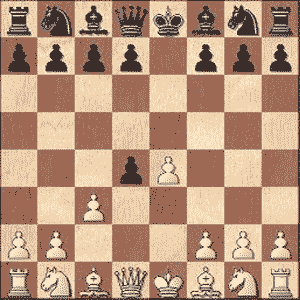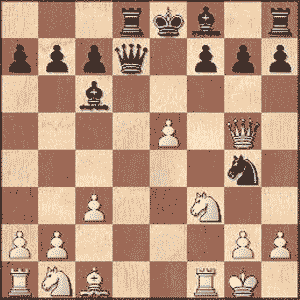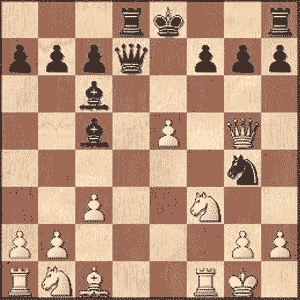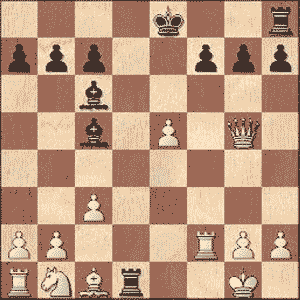| Back to Back Issues Page |
 |
|
LCB, Issue #119 --, Conquer the Home Rank with Tactics May 01, 2025 |
Conquer the Home Rank with TacticsChessorb Classic, Issue #119 -- GOTM #89 Chessorb Classic The Danish Gambit is an exciting choice for White which can lead to positions rich with attacking potential. Remember though, Black can fire back too. One of the most effective motifs that Black can pursue is an assault on e4. White uses his early moves in the Danish to mobilize his Queenside against Black's Kingside. Therefore his own Kingside is underdeveloped. The Queen's Knight also tends to remain at home for a while and the e4 pawn has paltry support. Attacking weak points in the enemy camp has many natural benefits. You force him to limit his pieces to passive supporting roles, effectively preventing them from attacking you. You also open the road for your forces to simultaneously attack other points. This month's game is a study on these ideas and also exploitation of home rank vulnerabilities. This game was played in Nuremburg, Germany in 1883. Jacques Schwarz had the White pieces and Siegbert Tarrasch played with Black. Conquer the Home Rank with TacticsSchwarz,Jacques - Tarrasch,Siegbert [C21]GotM #89 Nuremburg, 1883 [Connaughton, Ken] 1.e4 King's Pawn Game 1...e5 Closed Game 2.d4 Center Gambit 2...exd4 Center Game 3.c3
Danish Gambit 3...Qe7 A sideline in this position these days, but one that scores highly. 3...dxc3, 3...d5 and 3...d3 are much more routinely employed and give Black a safer game even if White has a small annoying edge. (3...dxc3 is the main continuation.; 3...d5 is another popular option.; 3...d3 is the third main idea.; 3...Nc6 along with 3...Nf6 and 3...d6 are the other less successful sidelines.; 3...Nf6; 3...d6) 4.f3?
makes this a unique game. (4.cxd4 was best here. 4...Qxe4+ 5.Be3 Nf6 6.Nc3 Bb4 7.Nf3 Nd5 8.Qd2 (8.Bd3) ; 4.Qxd4 was also possible; He also had 4.Bd3; Or 4.Qe2) 4...d5 continuing to pile on e4. Will attacking before development be a masterstroke or a catastrophe? 5.Qxd4 Nc6 6.Bb5 (6.Qxd5 Be6 7.Qd3 Nf6) 6...dxe4 7.fxe4 (7.Qxe4 Bd7 8.Qxe7+ Bxe7 9.Ne2 Nf6; 7.Bxc6+ bxc6) 7...Nf6 8.e5 Bd7 9.Bxc6 Bxc6 10.Nf3 The pawn seems more secure now and White will soon castle. 10...Rd8 Now Black's pieces spring into action. 11.Qe3 Ng4 12.Qg5! Giving himself the moment required to bring his King to safety. 12...Qd7Avoiding the exchange and holding the Knight. 13.0-0
The danger seems to have passed. The King has been swept to his castled position and it is Black who must address his King's security. 13...Bc5+
This resource however hands the edge back to Black who controls the dark diagonal. And with this move the assault on the King's stronghold begins. 14.Kh1 And of course the Knight will come in, in this familiar pattern. 14...Nf2+ The White Queen sits on a very vulnerable post at g5, but Black will exploit his majority of 2 heavies vs 1 in the battle for control of the home rank of White. 15.Rxf2 (15.Kg1 was no better: 15...Ne4+ 16.Kh1 (16.Be3 Nxg5 17.Bxc5-+) 16...Nxg5-+) 15...Qd1+! Important to play this before taking the Rook. (15...Bxf2 would have allowed. 16.h3) 16.Ng1 Qxg1+!! The touch of a master. Who among us amateurs would not have simply taken the Rook? (16...Bxf2 wins anyway but the textmove is far more eloquent.) 17.Kxg1 Rd1#
Clearly the pinned Rook cannot help, a beautiful #. 0-1 Schwarz, Jacques - Tarrasch, Siegbert [C21] P.S. If you do not have html based email software and you're using a text only system, you may find that the links are only partially highlighted and may not work. If this is the case, simply copy and paste the entire link into the browser and hit Enter. That should get you where you want to go. Comments, ideas, feedback? I'd be stoked to hear from you. Get in touch See you next month. Ken 
|
| Back to Back Issues Page |




